What Does The Future Hold For The Golf Industry After COVID-19?
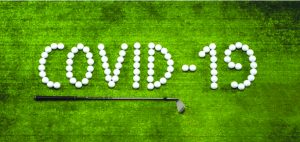 It started as a minor news story out of China, and for weeks, it stayed there. Then, reports of the deadly new virus grew ominous with various experts saying the fatality rate of the new virus was over three percent. Early models from Imperial College in the United Kingdom predicted that 2.2 million people would die in the United States if no mitigation procedures were undertaken and 1.1 million would die even if they were.
The COVID-19 coronavirus is not only the biggest story of 2020, it will undoubtedly be one of the biggest stories of the 21st century when the history books are written. The virus has upended daily life all over the planet. It wasn’t long before government officials worldwide began imposing “lockdowns” in an effort to combat the virus. People were ordered to stay home and venture out to only “essential” businesses that provided what were considered the necessities of life, such as food and personal items. Businesses deemed “non-essential” were ordered closed, putting tens of millions of Americans out of work.
Unfortunately, the sport of golf was deemed non-essential by many U.S. governors, and courses by the thousands lay idle. This, despite evidence that being outdoors was one of the best ways to not get the virus. This, despite the fact that the game of golf requires no one to get closer than six feet of another person (one of the mandates of “social distancing”), or that no one had to touch anything that someone else touched. However, other, more enlightened governors realized the benefits of golf and deemed courses essential businesses. These courses were allowed to remain open, with many choosing to alter some aspects. Namely, bunker rakes were removed and pool noodles were inserted in the hole so that retrieving a ball from the hole did not require removal of the flagstick or touching the bottom part of the flagstick in removing the ball from the cup. Water coolers were also taken away.
Many private clubs limited play to members only, with no guests or outside play allowed. Some courses closed their pro shops, taking payment outside and not accepting cash. One-rider-to-a-cart became the norm, and tee times spaced out at 15-minute intervals were implemented at many facilities.
Course dining rooms and clubhouses were closed. With economic damage mounting, states across the U.S. realized that they had to open businesses back up or risk a catastrophe on their hands that would eclipse any of the damage that the virus itself may have imposed – and that point may well have already been passed. Time will tell if the economy will recover or if tens of millions of lives will be destroyed in the sense of mental well being and financial health.
Scientific information is now coming in, showing that not only the shuttering of golf courses was completely unnecessary, but that many of the policies that courses implemented in the name of safety were virtually useless in combating the spread of infection. The Centers for Disease Control (CDC) recently stated that the virus is not easily spread through touch points indoors, much less outdoors. Golf Digest quoted Dr. Charles Prober, professor of immunology and microbiology at Stanford University, as saying, “[Handling the flagstick] is
an extraordinarily ineffective way of getting the disease.” According to Dr. Prober, a series of highly unlikely events would have to occur. First, someone sick with the disease would have to be playing. Second, that person would have to get the virus on their hands through coughing, sneezing, or otherwise transferring body fluids on their hands. Third, they would then have to touch the flagstick soon after.
Fourth, the next person to touch the flagstick would have to touch it in the same exact place as the infected person – assuming the virus was still on the flagstick (more on that later). Fifth, that next person would then have to introduce the virus into themselves by touching their eyes, nose, or mouth within a few minutes of touching the flagstick. In other words, as Dr. Prober pointed out, this highly improbable.
Dr. Amesh Adalja, from Johns Hopkins University, said on golfdigest.com that retrieving a ball from a hole presents “very minimal risks in those types of situations. You can dream up any kind of odd situation where the virus transmits in these special circumstances, but that wouldn’t be something I would be worried about.”
And since Dr. Prober and Dr. Adalja made these statements, new information has come out that the coronavirus doesn’t fare well in sunlight. Willliam Bryan of the Department of Homeland Security (DHS) said DHS research showed the virus having a half-life of two minutes in sunlight. This means that a maximum of 1/32 of the virus would be left on an outdoor surface after 10 minutes of sunlight
exposure. Therefore, it would seem handling a bunker rake is extremely safe, as well.
Dr. Ezekiel Emanual from the University of Pennsylvania, speaking on the television show Morning Joe, said that in order to get infected, “You need to see a prolonged amount of virus over a period of time. That happens indoors, not outdoors.” He also pointed out that there have been “very few” instances of people getting infected outdoors.
With all of that as the background, the headline of this article asks what’s in store for the future of the golf industry. Right now, signs are highly encouraging. Courses that were under lockdown have seen large waves of golfers. Even courses that were never closed have reported a decent increase in rounds played. Golf retail stores are also seeing business return to near normal, and on many days, exceed their corporate offices’ expectations. That’s not only good news for the retail operations, but also for the club manufacturers and suppliers of these stores.
Demographically, golf is currently faring well. Most golfers have either secure investment income or job security that withstood the economic shutdowns, so the majority of golfers should continue to play. The wild card is how soon the tens of millions of unemployed Americans return to the workforce, as they represent a smaller but significant portion of the golfing population. It would be foolish to venture a guess at this early stage, but hopefully the majority will not be without jobs for long.
The early models reporting that over a million Americans would lose their lives were egregiously wrong, as was the assumption the infection fatality rate was over three percent. While current research from a number of sources, including the Stanford University School of Medicine, the University of Southern California and the University of Bonn in Germany, as well as antibody studies done in Colorado, Massachusetts and New York all show the actual infection fatality rate is likely to be under one-half of one percent, the virus is still a very serious matter. While, as the saying goes, “so far, so good,” the golf industry needs to keep on its toes and continue to promote the game and make people feel confident that they can play without any significant risk.
It started as a minor news story out of China, and for weeks, it stayed there. Then, reports of the deadly new virus grew ominous with various experts saying the fatality rate of the new virus was over three percent. Early models from Imperial College in the United Kingdom predicted that 2.2 million people would die in the United States if no mitigation procedures were undertaken and 1.1 million would die even if they were.
The COVID-19 coronavirus is not only the biggest story of 2020, it will undoubtedly be one of the biggest stories of the 21st century when the history books are written. The virus has upended daily life all over the planet. It wasn’t long before government officials worldwide began imposing “lockdowns” in an effort to combat the virus. People were ordered to stay home and venture out to only “essential” businesses that provided what were considered the necessities of life, such as food and personal items. Businesses deemed “non-essential” were ordered closed, putting tens of millions of Americans out of work.
Unfortunately, the sport of golf was deemed non-essential by many U.S. governors, and courses by the thousands lay idle. This, despite evidence that being outdoors was one of the best ways to not get the virus. This, despite the fact that the game of golf requires no one to get closer than six feet of another person (one of the mandates of “social distancing”), or that no one had to touch anything that someone else touched. However, other, more enlightened governors realized the benefits of golf and deemed courses essential businesses. These courses were allowed to remain open, with many choosing to alter some aspects. Namely, bunker rakes were removed and pool noodles were inserted in the hole so that retrieving a ball from the hole did not require removal of the flagstick or touching the bottom part of the flagstick in removing the ball from the cup. Water coolers were also taken away.
Many private clubs limited play to members only, with no guests or outside play allowed. Some courses closed their pro shops, taking payment outside and not accepting cash. One-rider-to-a-cart became the norm, and tee times spaced out at 15-minute intervals were implemented at many facilities.
Course dining rooms and clubhouses were closed. With economic damage mounting, states across the U.S. realized that they had to open businesses back up or risk a catastrophe on their hands that would eclipse any of the damage that the virus itself may have imposed – and that point may well have already been passed. Time will tell if the economy will recover or if tens of millions of lives will be destroyed in the sense of mental well being and financial health.
Scientific information is now coming in, showing that not only the shuttering of golf courses was completely unnecessary, but that many of the policies that courses implemented in the name of safety were virtually useless in combating the spread of infection. The Centers for Disease Control (CDC) recently stated that the virus is not easily spread through touch points indoors, much less outdoors. Golf Digest quoted Dr. Charles Prober, professor of immunology and microbiology at Stanford University, as saying, “[Handling the flagstick] is
an extraordinarily ineffective way of getting the disease.” According to Dr. Prober, a series of highly unlikely events would have to occur. First, someone sick with the disease would have to be playing. Second, that person would have to get the virus on their hands through coughing, sneezing, or otherwise transferring body fluids on their hands. Third, they would then have to touch the flagstick soon after.
Fourth, the next person to touch the flagstick would have to touch it in the same exact place as the infected person – assuming the virus was still on the flagstick (more on that later). Fifth, that next person would then have to introduce the virus into themselves by touching their eyes, nose, or mouth within a few minutes of touching the flagstick. In other words, as Dr. Prober pointed out, this highly improbable.
Dr. Amesh Adalja, from Johns Hopkins University, said on golfdigest.com that retrieving a ball from a hole presents “very minimal risks in those types of situations. You can dream up any kind of odd situation where the virus transmits in these special circumstances, but that wouldn’t be something I would be worried about.”
And since Dr. Prober and Dr. Adalja made these statements, new information has come out that the coronavirus doesn’t fare well in sunlight. Willliam Bryan of the Department of Homeland Security (DHS) said DHS research showed the virus having a half-life of two minutes in sunlight. This means that a maximum of 1/32 of the virus would be left on an outdoor surface after 10 minutes of sunlight
exposure. Therefore, it would seem handling a bunker rake is extremely safe, as well.
Dr. Ezekiel Emanual from the University of Pennsylvania, speaking on the television show Morning Joe, said that in order to get infected, “You need to see a prolonged amount of virus over a period of time. That happens indoors, not outdoors.” He also pointed out that there have been “very few” instances of people getting infected outdoors.
With all of that as the background, the headline of this article asks what’s in store for the future of the golf industry. Right now, signs are highly encouraging. Courses that were under lockdown have seen large waves of golfers. Even courses that were never closed have reported a decent increase in rounds played. Golf retail stores are also seeing business return to near normal, and on many days, exceed their corporate offices’ expectations. That’s not only good news for the retail operations, but also for the club manufacturers and suppliers of these stores.
Demographically, golf is currently faring well. Most golfers have either secure investment income or job security that withstood the economic shutdowns, so the majority of golfers should continue to play. The wild card is how soon the tens of millions of unemployed Americans return to the workforce, as they represent a smaller but significant portion of the golfing population. It would be foolish to venture a guess at this early stage, but hopefully the majority will not be without jobs for long.
The early models reporting that over a million Americans would lose their lives were egregiously wrong, as was the assumption the infection fatality rate was over three percent. While current research from a number of sources, including the Stanford University School of Medicine, the University of Southern California and the University of Bonn in Germany, as well as antibody studies done in Colorado, Massachusetts and New York all show the actual infection fatality rate is likely to be under one-half of one percent, the virus is still a very serious matter. While, as the saying goes, “so far, so good,” the golf industry needs to keep on its toes and continue to promote the game and make people feel confident that they can play without any significant risk.


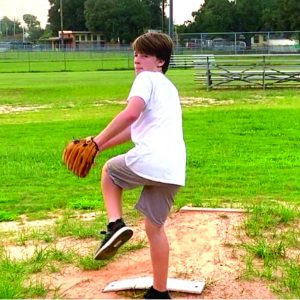 By Thomas T Wartelle WGTF Master Golf Teaching Professional Washington, Louisiana
The golf swing is a series of movements that takes a PGA Tour professional approximately 0.75 seconds for the backswing and 0.25 seconds
for the downswing, for a grand total of 1 second! The interesting thing is the 3:1 ratio of backswing to downswing. Studies have shown that the great players all had the similar 3:1 ratio. This certainly proves that timing and sequencing of the golf swing plays a big factor in long-term success. Interestingly, it has been found that most amateur golfers’ backswings are actually too slow and out of sequence to be consistently successful at impact.
Now, from a biomechanics standpoint, this is often caused by a backswing sequence that is just not as efficient as a tour player’s. A major
flaw often overlooked in amateur golfers is how the centers of their torso and pelvis move during the swing. The tour pro moves his centers slightly away from the target early in the backswing, like all athletic motions of throwing or swinging. This “early loading” occurs before the club shaft is parallel to the ground. It is typically only less than 1 inch. By the time a tour pro reaches the top of the backswing, their torso and pelvis re-center to their original position at address. One of the most interesting things is early in the downswing, their centers have moved ahead of the ball. This produces an optimal position to deliver an efficient and powerful impact.
High-handicap golfers tend to be much less efficient in their backswings. They do not do these sequences properly, or they do them too
late. Often, they continue to try to load away from the target late into the backswing. They feel like moving away from the target and trying
to maximize their turn creates more power. In reality, it just makes them later in getting their torso and pelvis centers into the proper downswing sequence. By trying to load too far and too late on the backswing, they end up working hard to try to “save” the shot. There is just not enough time on the downswing for them to deliver the club to a successful impact position.
Now, how do we relate this to instruction? Many instructors are using really great modern technology to pinpoint the flaws of a golf swing. Here is where instructors get it wrong: With all of their technology, pressure plates, launch monitors and metrics, they fail to convey the proper message to the student. Remember, the golf swing happens in a mere second from the move away until impact. Think about it: As a kid, did you analyze where your torso and pelvis centers were located when you tried to hit a baseball? Did you think about your weight distribution when you threw a ball? Did you think about your center of gravity when you started to jump?
Some people have more athletic awareness than others; however, most people have an innate ability to achieve some level of a golf swing goal. Granted, there can be some limitations, but mostly these innate abilities need to be activated or woken up. There are many thoughts and drills that one can use to achieve better swing sequencing. As an instructor, I try to use more active drills and feelings to achieve swing goals.
For example and thinking out of the box, there is my son, who is an up-and-coming junior golfer. He was not quite getting his swing sequencing where he wanted to be. I simply brought out a baseball and glove. As we began to throw, I encouraged him to throw harder and harder. The next time he hit balls, he instantly felt all of the swing sequencing described earlier. This positive result happened without rattling off metrics and going into a long biophysical explanation to the student. After all, golf is a results-oriented endeavor, and most students are looking for results.
As an instructor, I encourage the use of technology. But more importantly, learn how to apply the technology to help you convey the
message through active teaching. Technology is great, but not always really needed. A truly trained eye and analysis of the ball strike can discern most impact flaws. Technology only quantifies exact numbers. Students are generally not interested in the numbers and biomechanics. They are interested in hitting solid shots and playing better.
By Thomas T Wartelle WGTF Master Golf Teaching Professional Washington, Louisiana
The golf swing is a series of movements that takes a PGA Tour professional approximately 0.75 seconds for the backswing and 0.25 seconds
for the downswing, for a grand total of 1 second! The interesting thing is the 3:1 ratio of backswing to downswing. Studies have shown that the great players all had the similar 3:1 ratio. This certainly proves that timing and sequencing of the golf swing plays a big factor in long-term success. Interestingly, it has been found that most amateur golfers’ backswings are actually too slow and out of sequence to be consistently successful at impact.
Now, from a biomechanics standpoint, this is often caused by a backswing sequence that is just not as efficient as a tour player’s. A major
flaw often overlooked in amateur golfers is how the centers of their torso and pelvis move during the swing. The tour pro moves his centers slightly away from the target early in the backswing, like all athletic motions of throwing or swinging. This “early loading” occurs before the club shaft is parallel to the ground. It is typically only less than 1 inch. By the time a tour pro reaches the top of the backswing, their torso and pelvis re-center to their original position at address. One of the most interesting things is early in the downswing, their centers have moved ahead of the ball. This produces an optimal position to deliver an efficient and powerful impact.
High-handicap golfers tend to be much less efficient in their backswings. They do not do these sequences properly, or they do them too
late. Often, they continue to try to load away from the target late into the backswing. They feel like moving away from the target and trying
to maximize their turn creates more power. In reality, it just makes them later in getting their torso and pelvis centers into the proper downswing sequence. By trying to load too far and too late on the backswing, they end up working hard to try to “save” the shot. There is just not enough time on the downswing for them to deliver the club to a successful impact position.
Now, how do we relate this to instruction? Many instructors are using really great modern technology to pinpoint the flaws of a golf swing. Here is where instructors get it wrong: With all of their technology, pressure plates, launch monitors and metrics, they fail to convey the proper message to the student. Remember, the golf swing happens in a mere second from the move away until impact. Think about it: As a kid, did you analyze where your torso and pelvis centers were located when you tried to hit a baseball? Did you think about your weight distribution when you threw a ball? Did you think about your center of gravity when you started to jump?
Some people have more athletic awareness than others; however, most people have an innate ability to achieve some level of a golf swing goal. Granted, there can be some limitations, but mostly these innate abilities need to be activated or woken up. There are many thoughts and drills that one can use to achieve better swing sequencing. As an instructor, I try to use more active drills and feelings to achieve swing goals.
For example and thinking out of the box, there is my son, who is an up-and-coming junior golfer. He was not quite getting his swing sequencing where he wanted to be. I simply brought out a baseball and glove. As we began to throw, I encouraged him to throw harder and harder. The next time he hit balls, he instantly felt all of the swing sequencing described earlier. This positive result happened without rattling off metrics and going into a long biophysical explanation to the student. After all, golf is a results-oriented endeavor, and most students are looking for results.
As an instructor, I encourage the use of technology. But more importantly, learn how to apply the technology to help you convey the
message through active teaching. Technology is great, but not always really needed. A truly trained eye and analysis of the ball strike can discern most impact flaws. Technology only quantifies exact numbers. Students are generally not interested in the numbers and biomechanics. They are interested in hitting solid shots and playing better.
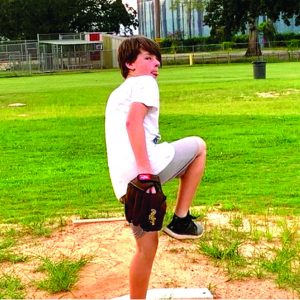 Learn active drills and exercises that can help each student of yours reach their maximum potential. Keep informed and keep learning new
techniques. However, pay homage to the past, as nothing is really new in athletic motion. We just learn different ways to convey the message. I recently learned a new thing too: I need a better catcher’s mitt and protection from my son’s lefthanded fastball!
Learn active drills and exercises that can help each student of yours reach their maximum potential. Keep informed and keep learning new
techniques. However, pay homage to the past, as nothing is really new in athletic motion. We just learn different ways to convey the message. I recently learned a new thing too: I need a better catcher’s mitt and protection from my son’s lefthanded fastball!
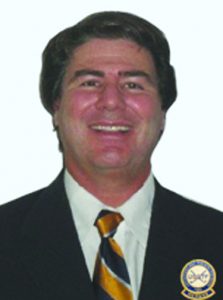 By Mark Harman
USGTF Course Director
Ridgeland, South Carolina
My teaching career began in early 1989 with The Florida Golf School, before there was a USGTF. In order to get my feet wet, I was assigned
to teach beginners. I was told to teach them the basics, and I knew enough about them to get by. Although I was about a 2-handicapper at this time, I soon learned there is a world of difference between having knowledge of the basics and how to impart them.
Fortunately, I had a number of very good mentors who helped me along the way. In particular (and these names might be familiar to some of you old-timers), Mitch Crum, Chris Kelly, Jack Feola, Doug Freeman and Judy Garvey helped guide me, patiently answering my seemingly endless questions. They showed me drills to fix certain problems and certain swing concepts.
Also instrumental was Dr. Gregg Steinberg, who was attending Florida State University at the time earning his Masters degree. Gregg and I met at Seminole Golf Course in Tallahassee, where I lived at the time. He really helped me understand the concept that the lower body starting the downswing was instrumental in how a golfer returns the clubhead into the ball, particularly the clubhead path.
All of these things I learned I still use today. However, it would be inaccurate for me to say I still teach the same way. I’ve always appreciated the John Dana quote, “He who dares to teach must never cease to learn.” And USGTF Hall of Fame teacher David Vaught’s words always inspired me: “I never want to give a bad lesson.” David’s mantra drives me more than he knows – until he reads this. I’ve earned further certifications with Dr. Ralph Mann and his ModelGolf – now SwingModel – methodology, and with Dr. David Wright and his Wright Balance system. I’ve read more about motor learning than I ever thought I would.
It’s also important to keep an open mind and try new things and not get stuck in the same old teaching style and using the same old corrections over and over. That’s because the corrections that might work on 7 out of 10 students may not work on the other three. It’s also because a certain teaching style might not appeal to a significant number of students.
As I’ve gotten more and more into giving individual lessons once again, I have made four significant changes to my way of teaching. The first is I willingly admit to the student when something I recommend is not working. In the past, I might have told them to just keep working on it and eventually they will get it. While there could be some truth or even a complete truth to that for some students, my ego is such that I will say, “Well, that didn’t work. Let’s try to figure out something that will.”
The second is my willingness to experiment more, which kind of goes along with the first change I mentioned. I let them know that we
need to find out what works for them, what they are capable or not capable of doing. Back in the day, my insecurity might have prevented me
from doing this, lest the student think I don’t know what I’m doing. But I now know, at least for me, that this is important for me to do if I’m to have any success.
The third is getting the student to swing on plane, or at least closer to it. It’s ironic, because Dr. Mann doesn’t believe in swing planes, but
I’ve found that the closer a student can keep the shaft parallel to the initial shaft plane at address somewhere in the downswing, the better the ball striking that student will have. To help achieve this, I use a U.S. Kids Golf measuring stick (just over five feet [152 cm] long). I hope I can explain this correctly. If the student is right-handed, I will stand to their right so I am along the extension of the target line. I hold the stick parallel with their stance and make them swing back and forward under the stick, which prevents them from coming in too steep into the ball. On rare occasions, I’ve had students who swing too flat or too much around their bodies, so they have to swing over the stick. This simple training aid has worked wonders for many of my students.
The fourth change involves my using four new drills. One involves the U.S. Kids Golf measuring stick as described earlier. The second involves hitting shots one-handed with the lead hand (left hand for a right-hander). It’s interesting how weak most people’s lead sides are, and you see it manifested with the trail right hand and arm dominating the downswing, producing casting and over-the-top. I sometimes combine this with a drill where they let go of the club with the dominant hand at impact, a drill I’ve long used.
The third new drill is having students hold the club from the wrong end so the grip is where the clubhead would be. I have them make a whoosh sound, and a lot of students make the whoosh before impact. I tell them I want to hear it at or past impact, and to make it as loud as possible. I will then video them while they are doing this, and visually it’s astounding how many people make a swing that looks like a low-handicapper’s. I heard this was one of Peter Kostis’ favorite drills, so I’m in good company there. The fourth drill involves having students actually throw the club down the target line just after where impact would be. Fred Shoemaker, a top teacher, is famous for this, and it really drives home the point that the club should be swung freely through impact.
In keeping with what drives David Vaught, the question is, do I ever give a bad lesson? Unfortunately, I have to believe that I do. When
I can’t get a student to make the necessary changes, right or wrong, I feel that’s on me. Other teachers have said they have the same problem,
and I read where even David Leadbetter said there are students with whom he can’t help. But still, it gnaws at me that I could have – should have – found a way to help them. I’ve also had students who have made the suggested changes but saw no improvement, or worse yet, regression, in their games.
So please, keep evolving as a teacher. This is not to say you have to change your core convictions about how or what to teach, but strive
to learn something new about teaching every now and then. At the end of your career, you’ll be amazed at how far you’ve come.
By Mark Harman
USGTF Course Director
Ridgeland, South Carolina
My teaching career began in early 1989 with The Florida Golf School, before there was a USGTF. In order to get my feet wet, I was assigned
to teach beginners. I was told to teach them the basics, and I knew enough about them to get by. Although I was about a 2-handicapper at this time, I soon learned there is a world of difference between having knowledge of the basics and how to impart them.
Fortunately, I had a number of very good mentors who helped me along the way. In particular (and these names might be familiar to some of you old-timers), Mitch Crum, Chris Kelly, Jack Feola, Doug Freeman and Judy Garvey helped guide me, patiently answering my seemingly endless questions. They showed me drills to fix certain problems and certain swing concepts.
Also instrumental was Dr. Gregg Steinberg, who was attending Florida State University at the time earning his Masters degree. Gregg and I met at Seminole Golf Course in Tallahassee, where I lived at the time. He really helped me understand the concept that the lower body starting the downswing was instrumental in how a golfer returns the clubhead into the ball, particularly the clubhead path.
All of these things I learned I still use today. However, it would be inaccurate for me to say I still teach the same way. I’ve always appreciated the John Dana quote, “He who dares to teach must never cease to learn.” And USGTF Hall of Fame teacher David Vaught’s words always inspired me: “I never want to give a bad lesson.” David’s mantra drives me more than he knows – until he reads this. I’ve earned further certifications with Dr. Ralph Mann and his ModelGolf – now SwingModel – methodology, and with Dr. David Wright and his Wright Balance system. I’ve read more about motor learning than I ever thought I would.
It’s also important to keep an open mind and try new things and not get stuck in the same old teaching style and using the same old corrections over and over. That’s because the corrections that might work on 7 out of 10 students may not work on the other three. It’s also because a certain teaching style might not appeal to a significant number of students.
As I’ve gotten more and more into giving individual lessons once again, I have made four significant changes to my way of teaching. The first is I willingly admit to the student when something I recommend is not working. In the past, I might have told them to just keep working on it and eventually they will get it. While there could be some truth or even a complete truth to that for some students, my ego is such that I will say, “Well, that didn’t work. Let’s try to figure out something that will.”
The second is my willingness to experiment more, which kind of goes along with the first change I mentioned. I let them know that we
need to find out what works for them, what they are capable or not capable of doing. Back in the day, my insecurity might have prevented me
from doing this, lest the student think I don’t know what I’m doing. But I now know, at least for me, that this is important for me to do if I’m to have any success.
The third is getting the student to swing on plane, or at least closer to it. It’s ironic, because Dr. Mann doesn’t believe in swing planes, but
I’ve found that the closer a student can keep the shaft parallel to the initial shaft plane at address somewhere in the downswing, the better the ball striking that student will have. To help achieve this, I use a U.S. Kids Golf measuring stick (just over five feet [152 cm] long). I hope I can explain this correctly. If the student is right-handed, I will stand to their right so I am along the extension of the target line. I hold the stick parallel with their stance and make them swing back and forward under the stick, which prevents them from coming in too steep into the ball. On rare occasions, I’ve had students who swing too flat or too much around their bodies, so they have to swing over the stick. This simple training aid has worked wonders for many of my students.
The fourth change involves my using four new drills. One involves the U.S. Kids Golf measuring stick as described earlier. The second involves hitting shots one-handed with the lead hand (left hand for a right-hander). It’s interesting how weak most people’s lead sides are, and you see it manifested with the trail right hand and arm dominating the downswing, producing casting and over-the-top. I sometimes combine this with a drill where they let go of the club with the dominant hand at impact, a drill I’ve long used.
The third new drill is having students hold the club from the wrong end so the grip is where the clubhead would be. I have them make a whoosh sound, and a lot of students make the whoosh before impact. I tell them I want to hear it at or past impact, and to make it as loud as possible. I will then video them while they are doing this, and visually it’s astounding how many people make a swing that looks like a low-handicapper’s. I heard this was one of Peter Kostis’ favorite drills, so I’m in good company there. The fourth drill involves having students actually throw the club down the target line just after where impact would be. Fred Shoemaker, a top teacher, is famous for this, and it really drives home the point that the club should be swung freely through impact.
In keeping with what drives David Vaught, the question is, do I ever give a bad lesson? Unfortunately, I have to believe that I do. When
I can’t get a student to make the necessary changes, right or wrong, I feel that’s on me. Other teachers have said they have the same problem,
and I read where even David Leadbetter said there are students with whom he can’t help. But still, it gnaws at me that I could have – should have – found a way to help them. I’ve also had students who have made the suggested changes but saw no improvement, or worse yet, regression, in their games.
So please, keep evolving as a teacher. This is not to say you have to change your core convictions about how or what to teach, but strive
to learn something new about teaching every now and then. At the end of your career, you’ll be amazed at how far you’ve come. 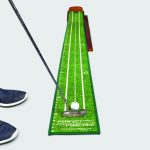 Customers have called Perfect Practice Putting Mat the gold standard of putting mats, a must have and a go-to rainy-day practice tool, but this product has genuine fans you can look up on YouTube or Instagram. Check out @GolferGirlEm, for example. Among the numerous PGA Tour player endorsements, you will see Charles Howell III, Vijay Singh, Taylor Gooch, Marc Leishman, Lydia Ko, Jimmy Walker and Nelly Korda, along with Dustin Johnson, who is the product’s official endorser and spokesperson.
The original Perfect Practice Putting Mat that has received such acclaim is the 9’ 6” (2.9 m) standard model, but the company has just
released an 8’ (2.44 m) compact and a 15’ 6” (4.72 m) XL version. However, buyer beware…the XL version seems even longer when you are putting to the small hole for a bet. I was really close! It should have gone in, actually, and we never shook hands. You can’t bet real money on an elbow bump.
PuttOUT Pressure Trainer
Customers have called Perfect Practice Putting Mat the gold standard of putting mats, a must have and a go-to rainy-day practice tool, but this product has genuine fans you can look up on YouTube or Instagram. Check out @GolferGirlEm, for example. Among the numerous PGA Tour player endorsements, you will see Charles Howell III, Vijay Singh, Taylor Gooch, Marc Leishman, Lydia Ko, Jimmy Walker and Nelly Korda, along with Dustin Johnson, who is the product’s official endorser and spokesperson.
The original Perfect Practice Putting Mat that has received such acclaim is the 9’ 6” (2.9 m) standard model, but the company has just
released an 8’ (2.44 m) compact and a 15’ 6” (4.72 m) XL version. However, buyer beware…the XL version seems even longer when you are putting to the small hole for a bet. I was really close! It should have gone in, actually, and we never shook hands. You can’t bet real money on an elbow bump.
PuttOUT Pressure Trainer
 People like learning through games. Take a difficult task like striking a ball with the equivalent consistency of hitting a bullseye on a dartboard, and you can imagine what the PuttOUT Pressure Trainer is like. One difference is, you can hit a bullseye with a throw that is
excessively hard or easy but arced, whereas you cannot make the ball stay on the ramp of PuttOUT with a putt that is too easy or too hard. very now and again we receive a complaint that the product doesn’t work, which always makes me chuckle and think to myself, “Being good is harder than you think.”
Give a PuttOUT to any young player, and they will become obsessed with mastering it. If you want to teach line and speed, start your layers one foot away and let them take the ten-putt challenge. Allow them to move one foot back each time they can get a ball to stay on the ramp within ten balls. If they can make one ball before their ten run out, they get to move back a foot. This PuttOUT drill is simple, engaging and super fun! PuttOUTs come in a range of colors, great for creating team challenges or stations with easy identifiers.
People like learning through games. Take a difficult task like striking a ball with the equivalent consistency of hitting a bullseye on a dartboard, and you can imagine what the PuttOUT Pressure Trainer is like. One difference is, you can hit a bullseye with a throw that is
excessively hard or easy but arced, whereas you cannot make the ball stay on the ramp of PuttOUT with a putt that is too easy or too hard. very now and again we receive a complaint that the product doesn’t work, which always makes me chuckle and think to myself, “Being good is harder than you think.”
Give a PuttOUT to any young player, and they will become obsessed with mastering it. If you want to teach line and speed, start your layers one foot away and let them take the ten-putt challenge. Allow them to move one foot back each time they can get a ball to stay on the ramp within ten balls. If they can make one ball before their ten run out, they get to move back a foot. This PuttOUT drill is simple, engaging and super fun! PuttOUTs come in a range of colors, great for creating team challenges or stations with easy identifiers.
 The company that makes PuttOUT has always had a vision of creating an indoor putting studio. Last year they introduced their ultra smooth PuttOUT Pro putting mat, but new in 2020 are their Putting Gate and PuttOUT Putting Mirror. The company is meticulous about both the design and construction of their products. For example, their mirror features a scratch-resistant coating, a stainless-steel
base so the mirror will not warp, a textured bottom so the product will not slip, and magnetic rails that may be configured for stroke patterns
and drills.
Other products have helped us through the crunch, as well. Nearly every article I seem to make mention of Martin Chuck’s Smart Ball, which is still going strong. We also picked up Jamie Brittain’s Swing Plate, along with the line of Sure-Set products from Dan Frost and Martin Hall, which are all excellent. That said, it has definitely been putting products that have helped us keep the ball rolling so far in 2020.
The company that makes PuttOUT has always had a vision of creating an indoor putting studio. Last year they introduced their ultra smooth PuttOUT Pro putting mat, but new in 2020 are their Putting Gate and PuttOUT Putting Mirror. The company is meticulous about both the design and construction of their products. For example, their mirror features a scratch-resistant coating, a stainless-steel
base so the mirror will not warp, a textured bottom so the product will not slip, and magnetic rails that may be configured for stroke patterns
and drills.
Other products have helped us through the crunch, as well. Nearly every article I seem to make mention of Martin Chuck’s Smart Ball, which is still going strong. We also picked up Jamie Brittain’s Swing Plate, along with the line of Sure-Set products from Dan Frost and Martin Hall, which are all excellent. That said, it has definitely been putting products that have helped us keep the ball rolling so far in 2020.
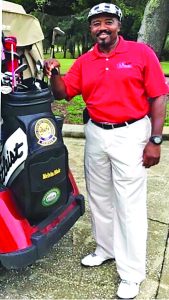 By Melvin Blair USGTF Member Tampa, Florida
Over the years, I invested in the launch monitor FlightScope, and now the Mevo+ is another part of the family. Now, things are better than ever! At BlairsGolf.com, we have the right numbers. The pros only play with the numbers, and you and your students can, as well! Students ask me all the time, “What element of my swing do I need to change?”
My first question is, “How much knowledge or understanding do you have of the ball flight laws?” You would be surprised how many students and coaches say, “Not much,” and that the numbers are confusing. My answer is, “Without the numbers, your golf swing is confusing!”
Something I learned: the ball is an object! It cannot see how pretty your swing looks or how tall you are or how much you weigh or whether you are playing well or poorly. It knows and responds to only one thing – impact, from the moment the clubhead strikes the ball to the moment they separate. The ball collects all the information that it needs to determine which direction, what distance and what trajectory to take. If the golf club strikes the ball with 120 mph of swing speed in the center of the clubface with same loft, clubface angle and swing path, it will go in the same place regardless of who is hitting it.
Ball flight laws are the most important information in which a teacher or student should have at least a reasonable level of knowledge. The knowledge gives us a great understanding of why the ball goes in the direction it is going. Without this knowledge, we can’t give such information as the true angle of attack, clubhead speed, club path, face angle, face-to-path or smash factor. I tell students, if you notice your golf ball when it is in the air for a long time with your slice, there is a good chance your spin is high. If your golf ball lacks rollout and seems to stop immediately when it lands, you are probably playing with high spin. If it seems like the ball lands softly and reacts immediately when it hits, there is a strong indication that you have high spin. And understanding how spin works and where your spin needs to be is the first step in fixing your slice, which is the evil of golf!
Golf instructors now know the important relationships between two critical things – the clubface angle and the club swing path. They know this is the key to understanding the slice. This can be done only with a launch monitor, because your eyes are not that good!
Club Data
• Club Speed
• Attack Angle
• Club Path
• Swing Plane
• Swing Direction
• Dynamic Loft
• Spin Loft
• Face Angle
• Face-to-Path
Ball Data
• Ball Speed
• Launch Angle
• Launch Direction
• Spin Axis
• Spin Rate
• Smash Factor
• Height
• Carry
Coach Melvin Blair is the golf coach for BlairsGolf.com, is a coach for the First Tee of Tampa Bay, ran the Disabled Veterans Golf Association, Inc., passed the V1/PGA Education Teaching and Technology advanced course, and is a member of the USGTF. Blair credits the USGTF for changing his golf life and giving him the tools he needed to teach and play golf at a high level.
By Melvin Blair USGTF Member Tampa, Florida
Over the years, I invested in the launch monitor FlightScope, and now the Mevo+ is another part of the family. Now, things are better than ever! At BlairsGolf.com, we have the right numbers. The pros only play with the numbers, and you and your students can, as well! Students ask me all the time, “What element of my swing do I need to change?”
My first question is, “How much knowledge or understanding do you have of the ball flight laws?” You would be surprised how many students and coaches say, “Not much,” and that the numbers are confusing. My answer is, “Without the numbers, your golf swing is confusing!”
Something I learned: the ball is an object! It cannot see how pretty your swing looks or how tall you are or how much you weigh or whether you are playing well or poorly. It knows and responds to only one thing – impact, from the moment the clubhead strikes the ball to the moment they separate. The ball collects all the information that it needs to determine which direction, what distance and what trajectory to take. If the golf club strikes the ball with 120 mph of swing speed in the center of the clubface with same loft, clubface angle and swing path, it will go in the same place regardless of who is hitting it.
Ball flight laws are the most important information in which a teacher or student should have at least a reasonable level of knowledge. The knowledge gives us a great understanding of why the ball goes in the direction it is going. Without this knowledge, we can’t give such information as the true angle of attack, clubhead speed, club path, face angle, face-to-path or smash factor. I tell students, if you notice your golf ball when it is in the air for a long time with your slice, there is a good chance your spin is high. If your golf ball lacks rollout and seems to stop immediately when it lands, you are probably playing with high spin. If it seems like the ball lands softly and reacts immediately when it hits, there is a strong indication that you have high spin. And understanding how spin works and where your spin needs to be is the first step in fixing your slice, which is the evil of golf!
Golf instructors now know the important relationships between two critical things – the clubface angle and the club swing path. They know this is the key to understanding the slice. This can be done only with a launch monitor, because your eyes are not that good!
Club Data
• Club Speed
• Attack Angle
• Club Path
• Swing Plane
• Swing Direction
• Dynamic Loft
• Spin Loft
• Face Angle
• Face-to-Path
Ball Data
• Ball Speed
• Launch Angle
• Launch Direction
• Spin Axis
• Spin Rate
• Smash Factor
• Height
• Carry
Coach Melvin Blair is the golf coach for BlairsGolf.com, is a coach for the First Tee of Tampa Bay, ran the Disabled Veterans Golf Association, Inc., passed the V1/PGA Education Teaching and Technology advanced course, and is a member of the USGTF. Blair credits the USGTF for changing his golf life and giving him the tools he needed to teach and play golf at a high level. 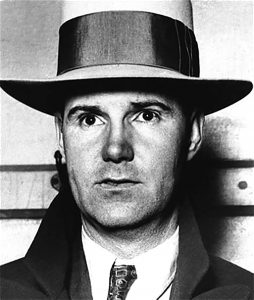 By Mike Stevens USGTF Member Tampa, Florida
Early golf in the United States was a gambler’s paradise, from legitimate wagers to more seedy pots controlled by mobsters. On the professional side, it was common for players to barnstorm the country, challenging locals to a money game backed by wealthy businessmen or scoundrels with several side bets among the gallery. It was pretty much a necessity, as professional tournament winnings barely covered expenses. Despite the so-called purity of amateur golf, some of the largest transfers of cash occurred at private clubs in Calcutta pools. It was just the way of the times, and one person was adept at taking advantage of gullible blue bloods around the country.
Alvin Clarence Thomas, aka Titanic Thompson, born on November 30, 1893, in southwest Missouri, became the most storied gambler in American history. Abandoned by his father, Alvin grew up on a farm in Rogers, Arkansas, with his mother and stepfather. An unruly child who disdained education, he left at age 16 with no money and entered the school of hard knocks. His street smarts would see him through a life of hustling and wagering on just about everything involving a gamble from cards to dice to pool, and even horseshoes. He spent hours on end honing his skills and could deal off the bottom of a deck of cards with both hands.
His card throwing skills were legendary, but many of his bets were set up skillfully to dupe the poor rube he suckered into a wager. He took special pleasure in swindling the rich and famous. One time he bet Al Capone he could throw a lemon over a five-story building. Capone picked a lemon from a nearby fruit vendor, but little did he know that Thompson’s sleight of hand changed out the lemon for one he had filled with buckshot. Capone handed over $500 as the lemon flew over the building.
Golf offered Titanic everything he loved: wagers of every kind and incessant hours of solitary practice. His relentless repetition with right- and left-handed clubs made him equally proficient from both sides of the ball. He spent a year just honing his skills before he set about challenging his marks at exclusive clubs of the rich and famous. All the while, he continued raking in cash from his flair with cards and pool cues. One day in the company of Capone and his entourage, Thompson declared that he could hit a 500-yard drive with a hickory club. Eager gamblers were ready to take him up on it, but he declared only when he was ready, “I have to feel it,” he said. So, one day in the middle of winter he announced that this was the day. Off they went to the local club and Titanic teed up the ball. There was as much as $50,000 on the line. Thompson addressed the ball and then turned around and launched the ball down the frozen lake behind the tee. The hoodwinked mobsters could only pay up as their convoluted code required them to honor the bet even if snookered.
Another story involves a time when Thompson said he could mark a ball with an X and hit it into a nearby pond and dive in and come up with the same ball. Little did the poor marks know that on the previous day, he hit several balls marked with an X into the pond. It was easy money. Now you understand the man and why the odds were always in his favor. Over the course of his golf life, he teamed with some of the most famous professional golfers of the era in big-money matches including Ben Hogan, Sam Snead and Byron Nelson. It was Thompson who arranged a famous match involving Ray Floyd and Lee Trevino with $100,000 on the line.
By Mike Stevens USGTF Member Tampa, Florida
Early golf in the United States was a gambler’s paradise, from legitimate wagers to more seedy pots controlled by mobsters. On the professional side, it was common for players to barnstorm the country, challenging locals to a money game backed by wealthy businessmen or scoundrels with several side bets among the gallery. It was pretty much a necessity, as professional tournament winnings barely covered expenses. Despite the so-called purity of amateur golf, some of the largest transfers of cash occurred at private clubs in Calcutta pools. It was just the way of the times, and one person was adept at taking advantage of gullible blue bloods around the country.
Alvin Clarence Thomas, aka Titanic Thompson, born on November 30, 1893, in southwest Missouri, became the most storied gambler in American history. Abandoned by his father, Alvin grew up on a farm in Rogers, Arkansas, with his mother and stepfather. An unruly child who disdained education, he left at age 16 with no money and entered the school of hard knocks. His street smarts would see him through a life of hustling and wagering on just about everything involving a gamble from cards to dice to pool, and even horseshoes. He spent hours on end honing his skills and could deal off the bottom of a deck of cards with both hands.
His card throwing skills were legendary, but many of his bets were set up skillfully to dupe the poor rube he suckered into a wager. He took special pleasure in swindling the rich and famous. One time he bet Al Capone he could throw a lemon over a five-story building. Capone picked a lemon from a nearby fruit vendor, but little did he know that Thompson’s sleight of hand changed out the lemon for one he had filled with buckshot. Capone handed over $500 as the lemon flew over the building.
Golf offered Titanic everything he loved: wagers of every kind and incessant hours of solitary practice. His relentless repetition with right- and left-handed clubs made him equally proficient from both sides of the ball. He spent a year just honing his skills before he set about challenging his marks at exclusive clubs of the rich and famous. All the while, he continued raking in cash from his flair with cards and pool cues. One day in the company of Capone and his entourage, Thompson declared that he could hit a 500-yard drive with a hickory club. Eager gamblers were ready to take him up on it, but he declared only when he was ready, “I have to feel it,” he said. So, one day in the middle of winter he announced that this was the day. Off they went to the local club and Titanic teed up the ball. There was as much as $50,000 on the line. Thompson addressed the ball and then turned around and launched the ball down the frozen lake behind the tee. The hoodwinked mobsters could only pay up as their convoluted code required them to honor the bet even if snookered.
Another story involves a time when Thompson said he could mark a ball with an X and hit it into a nearby pond and dive in and come up with the same ball. Little did the poor marks know that on the previous day, he hit several balls marked with an X into the pond. It was easy money. Now you understand the man and why the odds were always in his favor. Over the course of his golf life, he teamed with some of the most famous professional golfers of the era in big-money matches including Ben Hogan, Sam Snead and Byron Nelson. It was Thompson who arranged a famous match involving Ray Floyd and Lee Trevino with $100,000 on the line.
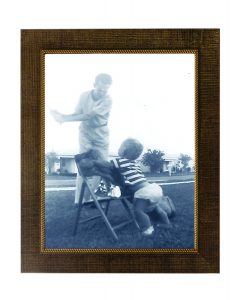 Wherever big money and gambling were, Titanic Thompson was around. When mobster Arnold Rothstein was murdered after a poker game where he refused to pay up, thinking the game was fixed, Thompson was one of the players at the table. Whether you approve or not, his life story is fascinating and worth the read. He’ll be forever known as the man who would bet on everything.
Wherever big money and gambling were, Titanic Thompson was around. When mobster Arnold Rothstein was murdered after a poker game where he refused to pay up, thinking the game was fixed, Thompson was one of the players at the table. Whether you approve or not, his life story is fascinating and worth the read. He’ll be forever known as the man who would bet on everything.
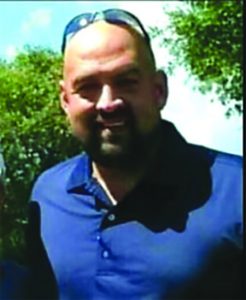 Arlen Bento Jr. is an award winning golf coach and “Top 100” world-recognized golf instructor. He is the former head golf professional of the PGA Country Club in PGA Village, Florida, and former director of golf/general manager of Eagle Marsh Golf Club in Jensen Beach, Florida. He operates his indoor golf center in Stuart, Florida, and his outdoor golf academy in Port St. Lucie, Florida, where he specializes in player development and offers his highly successful “Bento Golf Method” to players that want to learn how to get better. For more information, you can contact him via his website https://arlenbentojrgolflessons.com.
Arlen Bento Jr. is an award winning golf coach and “Top 100” world-recognized golf instructor. He is the former head golf professional of the PGA Country Club in PGA Village, Florida, and former director of golf/general manager of Eagle Marsh Golf Club in Jensen Beach, Florida. He operates his indoor golf center in Stuart, Florida, and his outdoor golf academy in Port St. Lucie, Florida, where he specializes in player development and offers his highly successful “Bento Golf Method” to players that want to learn how to get better. For more information, you can contact him via his website https://arlenbentojrgolflessons.com. 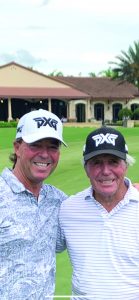 By Wayne Player, USGTF Member, Tequesta, Florida
Firstly, if you continue to do what you’ve always done, then you will continue to get the results you’ve always gotten. Change is the price of
survival, without question. One must focus on athletic fundamentals around power, balance and repetition.
My personal experience as a professional golfer and son of a golfing legend, Gary Player, led me to create a more simplified approach to
the game in The Player Approach. I have had more access to golf gurus, legends and sports psychologists than maybe anyone. You name
them, and I spent my dad’s money there as a young man. There are so many golfing teacher gurus out there that the golf world seems to be
inundated with a bunch of instructional malarkey. So, who is the guru of the gurus? I don’t know.
I would urge all of you to believe in a more simplified, four-pronged approach to eliminate paralyses of analysis:
1) a flat front foot/lead foot,
2) how to become a true front-foot hitter,
3) athleticism, and
4) a positive attitude.
Please see the next page for a greeting for Mr. Brandon Lee, president and CEO of the USGTF.
By Wayne Player, USGTF Member, Tequesta, Florida
Firstly, if you continue to do what you’ve always done, then you will continue to get the results you’ve always gotten. Change is the price of
survival, without question. One must focus on athletic fundamentals around power, balance and repetition.
My personal experience as a professional golfer and son of a golfing legend, Gary Player, led me to create a more simplified approach to
the game in The Player Approach. I have had more access to golf gurus, legends and sports psychologists than maybe anyone. You name
them, and I spent my dad’s money there as a young man. There are so many golfing teacher gurus out there that the golf world seems to be
inundated with a bunch of instructional malarkey. So, who is the guru of the gurus? I don’t know.
I would urge all of you to believe in a more simplified, four-pronged approach to eliminate paralyses of analysis:
1) a flat front foot/lead foot,
2) how to become a true front-foot hitter,
3) athleticism, and
4) a positive attitude.
Please see the next page for a greeting for Mr. Brandon Lee, president and CEO of the USGTF.
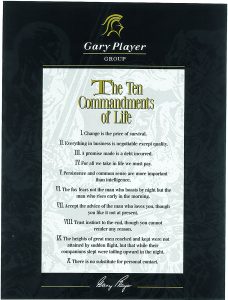 Dear Mr Lee,
We are all excited in welcoming you as the new owner and president of the USGTF. While Geoff Bryant certainly created an incredible
platform and service for golf teachers, we know that you will take the USGTF to great and exciting new horizons. A few of my dad Gary
Player’s commandments of life are: There is no substitute for personal contact; everything in business is negotiable except quality, and a
promise made is a debt incurred. There is no doubt that Mr Lee is an honorable and good man, and present members of the USGTF
should know that they are in great hands going forward.
I personally am looking forward to continue to work closely with you and your USGTF team in bringing new innovative ideas and products that we will offer all the existing members to assist them in becoming better teachers and mentors to their clients. We strongly believe in
your leadership and what the USGTF means to the golf teaching industry. Teaching and coaching the game of golf to those interested in learning and improving is a valuable and honorable profession. The game is always a healthy outlet for anyone, and the Player family is well known for valuing a healthy lifestyle and activities. Golf has given much to us, and we are pleased to see the USGTF giving so much to the game. Again, we look forward to working with you and wish you the best moving forward.
Sincerely,
Wayne Gary Player
Dear Mr Lee,
We are all excited in welcoming you as the new owner and president of the USGTF. While Geoff Bryant certainly created an incredible
platform and service for golf teachers, we know that you will take the USGTF to great and exciting new horizons. A few of my dad Gary
Player’s commandments of life are: There is no substitute for personal contact; everything in business is negotiable except quality, and a
promise made is a debt incurred. There is no doubt that Mr Lee is an honorable and good man, and present members of the USGTF
should know that they are in great hands going forward.
I personally am looking forward to continue to work closely with you and your USGTF team in bringing new innovative ideas and products that we will offer all the existing members to assist them in becoming better teachers and mentors to their clients. We strongly believe in
your leadership and what the USGTF means to the golf teaching industry. Teaching and coaching the game of golf to those interested in learning and improving is a valuable and honorable profession. The game is always a healthy outlet for anyone, and the Player family is well known for valuing a healthy lifestyle and activities. Golf has given much to us, and we are pleased to see the USGTF giving so much to the game. Again, we look forward to working with you and wish you the best moving forward.
Sincerely,
Wayne Gary Player 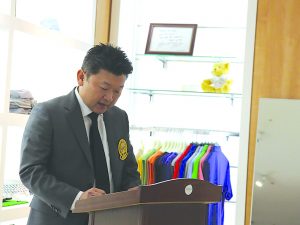 For 31 years, one man led the USGTF as its president and CEO. That would be founder Geoff Bryant, who in 1989 started a revolution in the golf teaching business that continues strong to this day.
Recently, Bryant said 31 years is enough and it’s time to ride off into retirement. Enter Brandon Lee, who assumed the titles of president and CEO in February. Lee was formerly the director of the USGTF’s foreign language courses and president of USGTF-Korea, among other entities. He also served as vice president of the World Golf Teachers Federation, the umbrella group that is comprised of more than 40 member nations.
Lee was born in South Korea and grew up there. As a kid, he participated in many sports due to the influence of his father. Lee’s dad also got him involved in golf in high school. He later completed his Ph.D in Exercise Biochemistry in Japan. After a career in that field, he came
to the United States and completed the USGTF certification program in 2005. He began his golf teaching career in Orange County, California,
in the cities of Irvine and Laguna Hills, where he operated a teaching academy.
His academy was extremely successful, the result of his business acumen and previous experiences, and this caught the attention of Bryant, who named Lee vice president of the USGTF in 2011. In that role, Lee established the USGTF’s foreign language courses (FLC), which were based on strong professional ethics and educational programs, while continuing to research and spread the latest golf teaching methods in the United States. This has helped foreigners in the United States earn USGTF certification and continue the organization’s progress as a leader in golf.
Here is a Q&A with the USGTF’s new president, Brandon Lee:
Q: Why did you want to become president/CEO of the USGTF?
A: The USGTF was started with a great mission envisioned by Geoff Bryant. I thought it was time for a new generation to continue the mission and continue the development. I worked through the ranks as a Certified Golf Teaching Professional, a Master Teaching Professional and FLC course director. It made sense to naturally progress into this role.
Q: What do you see as the USGTF’s future and what are your plans for it?
A: To make the USGTF certification more valuable by helping the members make money through teaching and employment, because the USGTF is a career choice. I also plan to work harder to define what a golf teaching professional is and does in the industry. Many in the golfing industry believe the USGTF is a secondary license below the PGA. I experienced the same problem when I started USGTF-Korea in 2016. But through my will and effort, the Korean golf industry moved to accept our status and our mission. As a result, they started to recognize USGTF is the best license to learn golf teaching methodology and KPGA members also started to join and learn our USGTF educational system.
Q: What do you see as one or more of the strengths of the USGTF?
A: With the slogan of “Learn to teach golf – the profession of a lifetime,” the USGTF provides an opportunity to challenge and inspire not
only existing professionals but also ordinary people who have a strong passion for golf. We have many golf enthusiasts, with diverse backgrounds, such as businessmen and retirees who are not golf professionals.
Q: In part, why has USGTF-Korea been so successful?
A: In Korea, the USGTF started as a minor player in golf. It is now composed of a large number of members from various professions who are not KPGA professionals. It is also a representative group for those who seek a second life through giving golf lessons. By promoting a
strong professional ethical sense of being a golf leader that combines teaching skills and developing the personalities of our teaching
professionals, it was able to grow into an organization that cultivates experts in teaching the game of golf.
Lee is committed to taking the USGTF to new heights as we are now well into the 21st century. His success with USGTF-Korea and the foreign language courses in the United States should bode well as the USGTF navigates its way in the ever-changing fields of golf instruction and golf business.
Lee has completed a move to Florida from California and oversees the daily operations of the USGTF from the national office, located in Fort Pierce, Florida. He welcomes member input and can be reached by email at president@usgtf.com.
For 31 years, one man led the USGTF as its president and CEO. That would be founder Geoff Bryant, who in 1989 started a revolution in the golf teaching business that continues strong to this day.
Recently, Bryant said 31 years is enough and it’s time to ride off into retirement. Enter Brandon Lee, who assumed the titles of president and CEO in February. Lee was formerly the director of the USGTF’s foreign language courses and president of USGTF-Korea, among other entities. He also served as vice president of the World Golf Teachers Federation, the umbrella group that is comprised of more than 40 member nations.
Lee was born in South Korea and grew up there. As a kid, he participated in many sports due to the influence of his father. Lee’s dad also got him involved in golf in high school. He later completed his Ph.D in Exercise Biochemistry in Japan. After a career in that field, he came
to the United States and completed the USGTF certification program in 2005. He began his golf teaching career in Orange County, California,
in the cities of Irvine and Laguna Hills, where he operated a teaching academy.
His academy was extremely successful, the result of his business acumen and previous experiences, and this caught the attention of Bryant, who named Lee vice president of the USGTF in 2011. In that role, Lee established the USGTF’s foreign language courses (FLC), which were based on strong professional ethics and educational programs, while continuing to research and spread the latest golf teaching methods in the United States. This has helped foreigners in the United States earn USGTF certification and continue the organization’s progress as a leader in golf.
Here is a Q&A with the USGTF’s new president, Brandon Lee:
Q: Why did you want to become president/CEO of the USGTF?
A: The USGTF was started with a great mission envisioned by Geoff Bryant. I thought it was time for a new generation to continue the mission and continue the development. I worked through the ranks as a Certified Golf Teaching Professional, a Master Teaching Professional and FLC course director. It made sense to naturally progress into this role.
Q: What do you see as the USGTF’s future and what are your plans for it?
A: To make the USGTF certification more valuable by helping the members make money through teaching and employment, because the USGTF is a career choice. I also plan to work harder to define what a golf teaching professional is and does in the industry. Many in the golfing industry believe the USGTF is a secondary license below the PGA. I experienced the same problem when I started USGTF-Korea in 2016. But through my will and effort, the Korean golf industry moved to accept our status and our mission. As a result, they started to recognize USGTF is the best license to learn golf teaching methodology and KPGA members also started to join and learn our USGTF educational system.
Q: What do you see as one or more of the strengths of the USGTF?
A: With the slogan of “Learn to teach golf – the profession of a lifetime,” the USGTF provides an opportunity to challenge and inspire not
only existing professionals but also ordinary people who have a strong passion for golf. We have many golf enthusiasts, with diverse backgrounds, such as businessmen and retirees who are not golf professionals.
Q: In part, why has USGTF-Korea been so successful?
A: In Korea, the USGTF started as a minor player in golf. It is now composed of a large number of members from various professions who are not KPGA professionals. It is also a representative group for those who seek a second life through giving golf lessons. By promoting a
strong professional ethical sense of being a golf leader that combines teaching skills and developing the personalities of our teaching
professionals, it was able to grow into an organization that cultivates experts in teaching the game of golf.
Lee is committed to taking the USGTF to new heights as we are now well into the 21st century. His success with USGTF-Korea and the foreign language courses in the United States should bode well as the USGTF navigates its way in the ever-changing fields of golf instruction and golf business.
Lee has completed a move to Florida from California and oversees the daily operations of the USGTF from the national office, located in Fort Pierce, Florida. He welcomes member input and can be reached by email at president@usgtf.com.
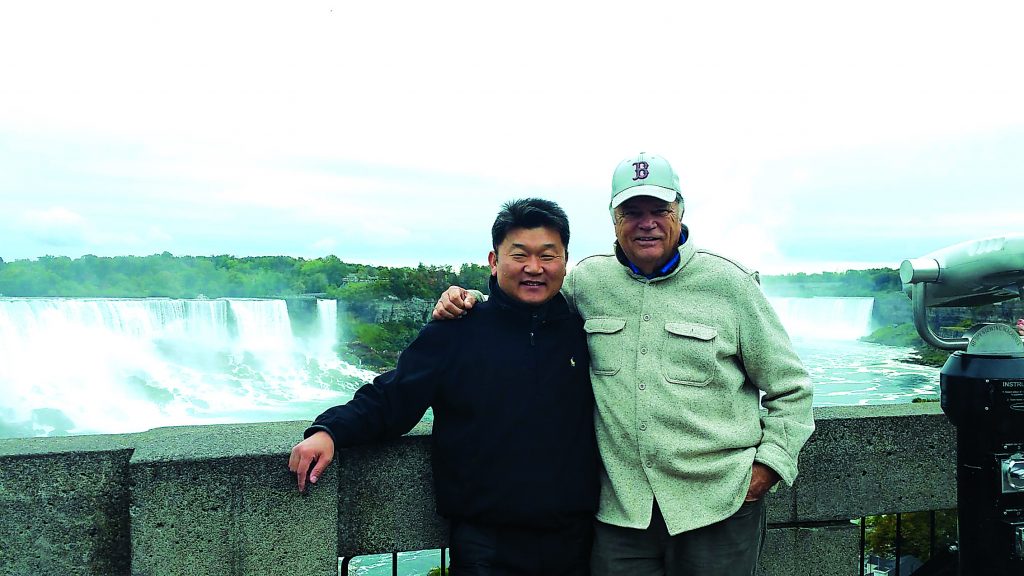
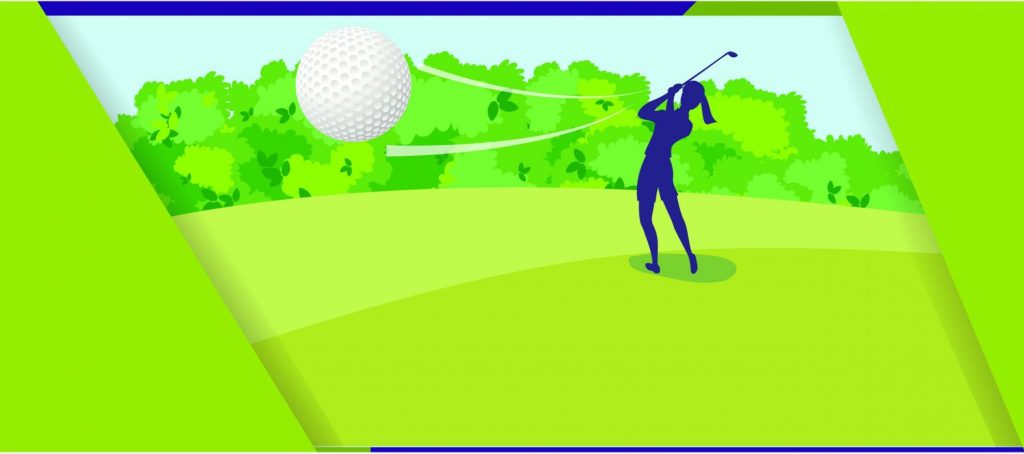 The COVID-19 coronavirus has certainly turned our world upside-down. Multiple businesses were forced to closed, including golf courses, when most American governors mandated that “nonessential” businesses do so. A philosophical point can be made that there are no businesses that are non-essential, because all businesses are essential to the owners that own them, employees who depend on their paychecks and the customers who rely on the products and services those businesses provide.
Gatherings of over 10 people were also either discouraged or declared illegal as government officials moved into action to try to stop the spread of the coronavirus. That effectively ended professional sports in the United States for a considerable period of time, including golf on the PGA Tour. The first round of The Players was completed in March when the Tour decided that it was not feasible to continue play and wound up canceling the tournament. Other events were either canceled or postponed, as well.
After three months of being shut down, the PGA Tour started play again on June 11 at Colonial Country Club in Fort Worth, Texas, and going forward, the experience will certainly be different for players and fans alike. For one, there actually will be no fans for the first four events; not even players’ families will be allowed on-site. It takes approximately 2,500 people to make a PGA Tour event happen, but the Tour plans to try to run with around 1,000 extra personnel at the venue. Virus testing will not be possible for everyone due to logistics, but screenings and questionnaires will be the norm.
Caddies will be required to clean the flagsticks and bunker rakes after they handle them, and both players and caddies are expected to sanitize their hands after the playing of each hole. Players are encouraged to pull the clubs out of the bag and return them without the caddie touching them. Players are also going to be the only ones allowed to pick their ball out of the hole. Both players and caddies will be tested for the virus before each event, and any player returning a positive test will be forced to withdraw from the tournament. Masks will also be provided for any player, caddie and essential personnel at the course.
A charter plane will also be made available to players and caddies alike, and only those who test negative for the virus within 24 hours of departure will be allowed to board. Players and caddies are expected to all stay at the same hotel, basically sequestered there with no travel outside the hotel except to the golf course. This includes staying in the hotel for all meals and not going out to a restaurant to eat.
Frankly, while these guidelines seem reasonable to the extent that stopping the spread of the virus is the main focus, they ignore the realities of human behavior. Expecting touring professionals to never leave the hotel unless they are going to the golf course might work for a week or two, but undoubtedly most players will tire of this forced routine of boredom. If their families are not allowed to be with them at the course, you can be sure that many players will skip the post-round practice routines that are prevalent and head straight back to the hotel to be with their families. However, not being able to take the little ones to a park, playground, etc., might weigh on the minds of the players and their spouses, and we could see some players deciding to stay home until things return more to normal.
Expecting players and caddies to sanitize their hands and anything on the course they might touch seems a bit unreasonable, too. Golf is being played all across the country, and currently there are no reports of players falling ill from being at the course. Epidemiologists who have weighed in have said that golf is one of the safest possible activities to engage in, and that’s even with our former way of doing things. And it’s seriously doubtful that any player will be playing with any sort of mask or face covering, although it’s possible that you might see some of the more physically compromised caddies doing so. However, various health experts have said that contracting the environment in an outdoor setting is extremely unlikely, so it will be interesting to see how many people on our television screens will be wearing them.
What will happen when fans are eventually allowed to return? That’s anyone’s guess. If we see corporate hospitality tents, they almost certainly will be of limited capacity so the guests can maintain social distancing of six feet or more apart from each other. Bleachers may exist, but sections or seats may be cordoned off so people aren’t sitting less than six feet apart. But then again, we might not see any hospitality tents or bleachers. We’ll just have to wait and see what happens with the first few events where fans are allowed.
When will things return completely to “normal”? Again, that’s anyone’s guess. Current reports at the time of this writing say a vaccine is at least 18 months away (which would be late 2021), and maybe much longer than that. With the current emphasis having shifted from “flattening the curve” so hospitals didn’t get overrun to “let’s keep the number of cases as low as possible for as long as possible” until a vaccine is developed, it’s possible nothing resembling normalcy might not happen for years.
That would be most unfortunate, but given the vagaries of human behavior, combined with the fact that forcing people into artificial behaviors for an extended period of time are not likely to work, we could well see a sea of change in the way both ordinary citizens and our authority figures want to handle this. Also, with research from the Stanford University School of Medicine, the University of Southern California/Los Angeles County Department of Public Health, the University of Bonn in Germany and Oxford University in England, among others, showing the infection fatality rate of the virus isn’t nearly as severe as first thought, there are some encouraging signs that not only golf, but life in general, may return to normal sooner than we may think possible at present.
The COVID-19 coronavirus has certainly turned our world upside-down. Multiple businesses were forced to closed, including golf courses, when most American governors mandated that “nonessential” businesses do so. A philosophical point can be made that there are no businesses that are non-essential, because all businesses are essential to the owners that own them, employees who depend on their paychecks and the customers who rely on the products and services those businesses provide.
Gatherings of over 10 people were also either discouraged or declared illegal as government officials moved into action to try to stop the spread of the coronavirus. That effectively ended professional sports in the United States for a considerable period of time, including golf on the PGA Tour. The first round of The Players was completed in March when the Tour decided that it was not feasible to continue play and wound up canceling the tournament. Other events were either canceled or postponed, as well.
After three months of being shut down, the PGA Tour started play again on June 11 at Colonial Country Club in Fort Worth, Texas, and going forward, the experience will certainly be different for players and fans alike. For one, there actually will be no fans for the first four events; not even players’ families will be allowed on-site. It takes approximately 2,500 people to make a PGA Tour event happen, but the Tour plans to try to run with around 1,000 extra personnel at the venue. Virus testing will not be possible for everyone due to logistics, but screenings and questionnaires will be the norm.
Caddies will be required to clean the flagsticks and bunker rakes after they handle them, and both players and caddies are expected to sanitize their hands after the playing of each hole. Players are encouraged to pull the clubs out of the bag and return them without the caddie touching them. Players are also going to be the only ones allowed to pick their ball out of the hole. Both players and caddies will be tested for the virus before each event, and any player returning a positive test will be forced to withdraw from the tournament. Masks will also be provided for any player, caddie and essential personnel at the course.
A charter plane will also be made available to players and caddies alike, and only those who test negative for the virus within 24 hours of departure will be allowed to board. Players and caddies are expected to all stay at the same hotel, basically sequestered there with no travel outside the hotel except to the golf course. This includes staying in the hotel for all meals and not going out to a restaurant to eat.
Frankly, while these guidelines seem reasonable to the extent that stopping the spread of the virus is the main focus, they ignore the realities of human behavior. Expecting touring professionals to never leave the hotel unless they are going to the golf course might work for a week or two, but undoubtedly most players will tire of this forced routine of boredom. If their families are not allowed to be with them at the course, you can be sure that many players will skip the post-round practice routines that are prevalent and head straight back to the hotel to be with their families. However, not being able to take the little ones to a park, playground, etc., might weigh on the minds of the players and their spouses, and we could see some players deciding to stay home until things return more to normal.
Expecting players and caddies to sanitize their hands and anything on the course they might touch seems a bit unreasonable, too. Golf is being played all across the country, and currently there are no reports of players falling ill from being at the course. Epidemiologists who have weighed in have said that golf is one of the safest possible activities to engage in, and that’s even with our former way of doing things. And it’s seriously doubtful that any player will be playing with any sort of mask or face covering, although it’s possible that you might see some of the more physically compromised caddies doing so. However, various health experts have said that contracting the environment in an outdoor setting is extremely unlikely, so it will be interesting to see how many people on our television screens will be wearing them.
What will happen when fans are eventually allowed to return? That’s anyone’s guess. If we see corporate hospitality tents, they almost certainly will be of limited capacity so the guests can maintain social distancing of six feet or more apart from each other. Bleachers may exist, but sections or seats may be cordoned off so people aren’t sitting less than six feet apart. But then again, we might not see any hospitality tents or bleachers. We’ll just have to wait and see what happens with the first few events where fans are allowed.
When will things return completely to “normal”? Again, that’s anyone’s guess. Current reports at the time of this writing say a vaccine is at least 18 months away (which would be late 2021), and maybe much longer than that. With the current emphasis having shifted from “flattening the curve” so hospitals didn’t get overrun to “let’s keep the number of cases as low as possible for as long as possible” until a vaccine is developed, it’s possible nothing resembling normalcy might not happen for years.
That would be most unfortunate, but given the vagaries of human behavior, combined with the fact that forcing people into artificial behaviors for an extended period of time are not likely to work, we could well see a sea of change in the way both ordinary citizens and our authority figures want to handle this. Also, with research from the Stanford University School of Medicine, the University of Southern California/Los Angeles County Department of Public Health, the University of Bonn in Germany and Oxford University in England, among others, showing the infection fatality rate of the virus isn’t nearly as severe as first thought, there are some encouraging signs that not only golf, but life in general, may return to normal sooner than we may think possible at present.